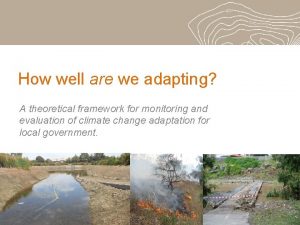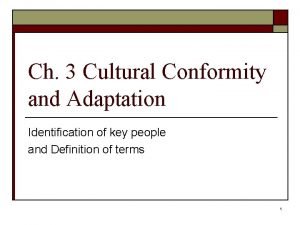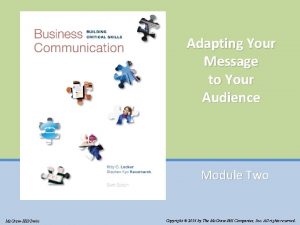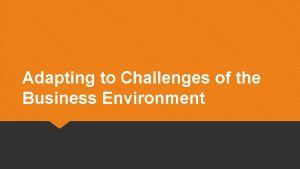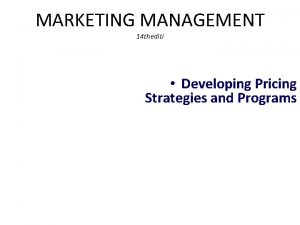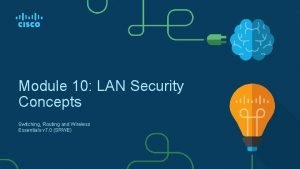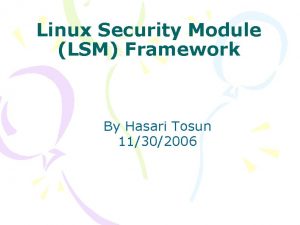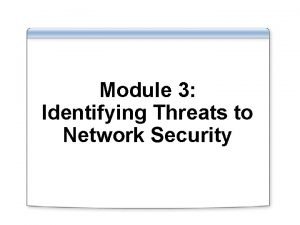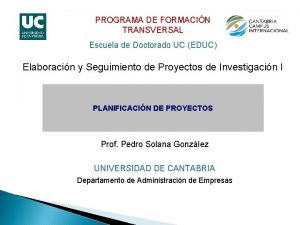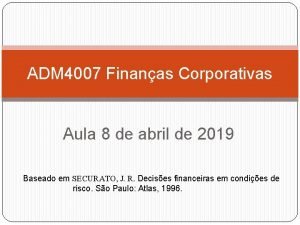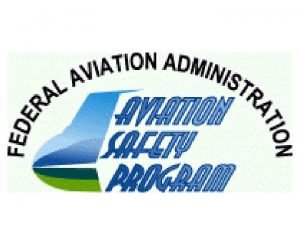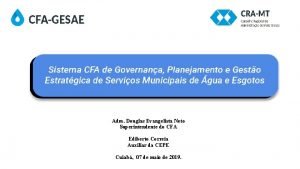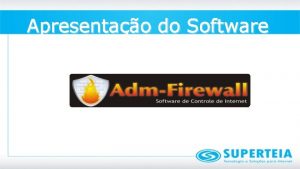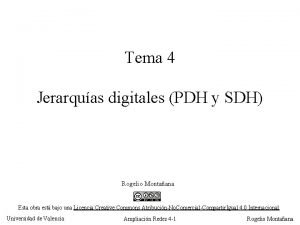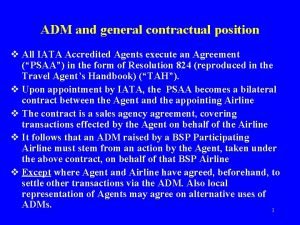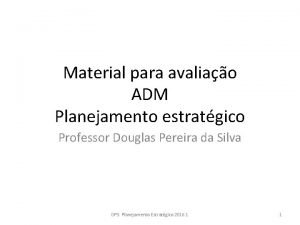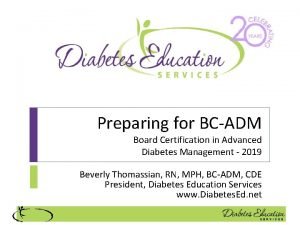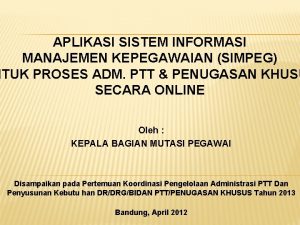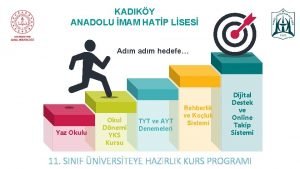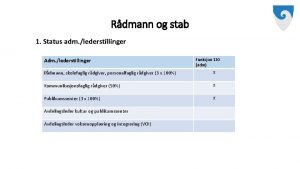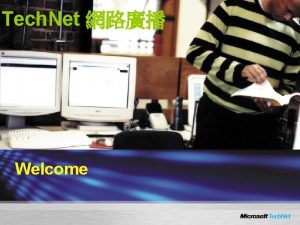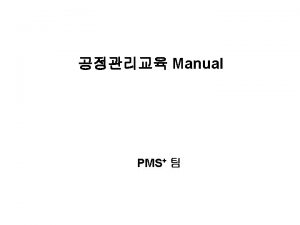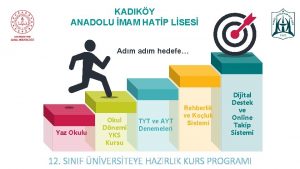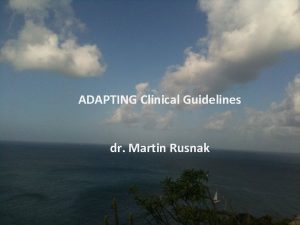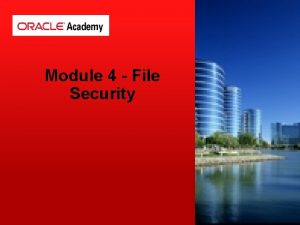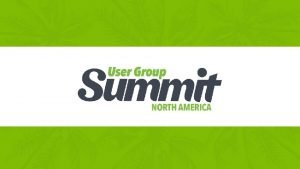Module 31 Adapting the ADM Security V 9































- Slides: 31

Module 31 Adapting the ADM: Security V 9 Edition Copyright © January 2009 Slide 1 of 31 All rights reserved Published by The Open Group, January 2009 TM

Security and the ADM Adapting the ADM: Security TOGAF is a trademark of The Open Group in the United States and other countries Slide 2 of 31 TM TM

Roadmap Part I - Introduction Preface, Executive Overview, Core Concepts, Definitions and Release Notes Part II – Architecture Development Method Introduction to ADM Phase Narratives Part III – ADM Guidelines and Techniques Guidelines for Adapting the ADM Process Techniques for Architecture Development Part IV – Architecture Content Framework • Part III, ADM Guidelines and Techniques, Chapter 21 Content Metamodel Architectural Artifacts Architecture Deliverables Building Blocks Part V – Enterprise Continuum and Tools Enterprise Continuum Architecture Partitioning Architecture Repository Tools for Architecture Development Part VI – Reference Models Foundation Architecture: Technical Reference Model Integrated Information Infrastructure Reference Model Part VII – Architecture Capability Framework Architecture Architecture Board Compliance Contracts Governance Maturity Models Skills Framework Slide 3 of 31 TM

Module Objectives The objectives of this module are: • Obtain an understanding of the security considerations that need to be addressed during application of the ADM Slide 4 of 31 TM

Security and the ADM • TOGAF introduces guidance to help practitioners avoid missing a critical security concern • The guidance is not intended to be a security architecture development methodology • It is intended to inform the enterprise architect of the security architecture task and role • Security objectives have been developed for each ADM Phase Slide 5 of 31 TM

Security Architecture Characteristics • Security architecture has its own methods • Security architecture composes its own discrete view and viewpoints • Security architecture addresses non-normative flows • Security architecture introduces its own unique normative flows • Security architecture introduces unique, single-purpose components in the design. • Security architecture calls for its own unique set of skill requirements in the enterprise architect Slide 6 of 31 TM

Stakeholder Concerns Executive Line Management IT Service Business Management Domain Experts Programme Management Office Authentication Authorization Audit Assurance Availability Asset Protection Administration Risk Management Line Management HR Cx. O Functional / Business Process Experts Application Management Infrastructure Management Procurement Data / Voice Communications Stakeholder Types Corporate Slide 7 of 31 System End - User Project QA / Standards Groups Product Specialists Enterprise Security Technical Specialists TM

Typical Security Artifacts • Business rules regarding handling of data/information assets • Written and published security policy • Codified data/information asset ownership and custody • Risk analysis documentation • Data classification policy documentation Slide 8 of 31 TM

TOGAF ADM Slide 9 of 31 TM

ADM Requirements Management • Security Policy and Security Standards become part of the requirements management process • New Security requirements arise from many sources: – A new statutory or regulatory mandate – A new threat realized or experienced – A new architecture initiative discovers new stakeholders with new requirements Slide 10 of 31 TM

Preliminary Phase • Define and document applicable regulatory and security policy requirements • Identify a security architect • Identify first-order assumptions and boundary conditions Slide 11 of 31 TM

Preliminary Phase – Inputs/Outputs • Inputs: – Written security policy – Relevant statutes – List of applicable jurisdictions Slide 12 of 31 • Outputs: – List of applicable regulations – List of applicable security policies – Security team roster – List of security assumptions and boundary conditions TM

Phase A Architecture Vision • • • Slide 13 of 31 Obtain management support for security measures Define necessary securityrelated management sign-off milestones Determine applicable disaster recovery or business continuity requirements Identify anticipated physical/ business, regulatory environments in which the systems will be deployed Determine the criticality of the system: safety-critical, missioncritical, non-critical TM

Phase A Architecture Vision – Inputs/Outputs • Inputs – List of applicable security policies – List of applicable jurisdictions – Complete disaster recover and continuity plans Slide 14 of 31 • Outputs – – Physical security statement Business security statement Regulatory security statement Security policy cover letter signed by CEO or delegate – List of architecture development checkpoints – List of disaster recover and business continuity plans – Systems criticality statement TM

Phase B Business Architecture • • Determine who are the legitimate actors who will interact with the system Assess and baseline current security-specific business processes Determine whom/how much it is acceptable to inconvenience with security measures Identify and document interconnecting systems beyond project control Determine the assets at risk if something goes wrong Determine the cost of asset loss/impact in failure cases Identify and document the ownership of assets Continued Slide 15 of 31 TM

Phase B Business Architecture • • • Slide 16 of 31 Determine and document appropriate security forensic processes Identify the criticality of the availability and correct operation of the overall service Determine and document how much security (cost) is justified by the threats and value of the assets Reassess and confirm Architecture Vision decisions Assess alignment or conflict of identified security policies with business goals Determine “what can go wrong? ” TM

Phase B: Business Architecture – Inputs/Outputs • Inputs – Initial business and regulatory security statements – List of applicable disaster recovery and business continuity plans – List of applicable security policies and regulations Slide 17 of 31 • Outputs – List of forensic processes – List of new disaster recovery and business continuity requirements – Validated business and regulatory environment statements – List of validated security policies and regulations – List of target security processes – List of baseline security processes – List of security actors – List of interconnecting systems – Statement of security tolerance for each class of security actor – Asset list with values and owners – List of trust paths – Availability impact statement(s) – Threat analysis matrix TM

Phase C Information Systems Architectures • Assess and baseline current security-specific architecture elements • Identify safe default actions and failure states • Identify and evaluate applicable recognized guidelines and standards • Revisit assumptions regarding interconnecting systems beyond project control • Determine and document the sensitivity or classification level of information stored/created/used • Identify and document custody of assets Continued Slide 18 of 31 TM

Phase C Information Systems Architectures • • Slide 19 of 31 Identify the criticality of the availability and correct operation of each function Determine the relationship of the system under design with existing business disaster/continuity plans Identify what aspects of the system must be configurable to reflect changes in policy/business environment/access control Identify lifespan of information used as defined by business needs and regulatory requirements Continued TM

Phase C Information Systems Architectures • Determine approaches to address identified risks • Identify actions/events that warrant logging for later review or triggering forensic processes • Identify and document requirements for rigor in proving accuracy of logged events (non-repudiation) • Identify potential/likely avenues of attack • Determine "what can go wrong? " Slide 20 of 31 TM

Phase C: Information Systems Architectures – Inputs/Outputs • Inputs – – Threat analysis matrix Risk analysis Documented forensic processes Validated business policies and regulations – List of interconnecting systems – New disaster recovery and business continuity requirements Slide 21 of 31 • Outputs – Event log-level matrix and requirements – Risk management strategy – Data lifecycle definitions – List of configurable system elements – Baseline list of security-related elements of the system – New or augmented security-related elements of the system – Security use-case models – List of applicable security standards: – Validated interconnected system list – Information classification report – List of asset custodians – Function criticality statement – Revised disaster recovery and business continuity plans – Refined threat analysis matrix TM

Phase D Technology Architecture • • • Assess and baseline current security-specific technologies Revisit assumptions regarding interconnecting systems beyond project control Identify and evaluate applicable recognized guidelines and standards Identify methods to regulate consumption of resources Engineer a method by which the efficacy of security measures will be measured and communicated on an ongoing basis Continued Slide 22 of 31 TM

Phase D Technology Architecture • Identify the trust (clearance) levels for the system • Identify minimal privileges required for any entity to achieve a technical or business objective • Identify mitigating security measures, where justified by risk assessment • Determine "what can go wrong? " Slide 23 of 31 TM

Phase D: Technology Architecture – Inputs/Outputs • Inputs – List of security-related elements of the system – List of interconnected systems – List of applicable security standards – List of security actors – Risk management strategy – Validated security policies – Validated regulatory requirements – Validated business policies related to trust requirements Slide 24 of 31 • Outputs – Baseline list of security technologies – Validated interconnected systems list – Selected security standards list – Resource conservation plan – Security metrics and monitoring plan – User authorization policies – Risk management plan – User trust (clearance) requirements TM

Phase E Opportunities and Solutions • Identify existing security services available for re-use • Engineer mitigation measures addressing identified risks • Evaluate tested and re-usable security software and resources • Identify new code/resources/assets appropriate for re-use • Determine “what can go wrong? ” Slide 25 of 31 TM

Phase F Migration Planning • • • Slide 26 of 31 Assess the impact of new security measures upon other new components or existing systems Implement assurance methods by which the efficacy of security measures will be measured and communicated on an ongoing basis Identify correct secure installation parameters, initial conditions, and configurations Implement disaster recovery and business continuity plans Determine "what can go wrong? " TM

Phase G Implementation Governance • Establish design and code reviews • Implement methods and procedures to review evidence that reflects operational stability and adherence to security policies • Implement training to ensure correct deployment, configuration and operations • Determine “What has gone wrong? ” Slide 27 of 31 TM

Phase H Architecture Change Management • Determine “What has gone wrong? ” • Incorporate security-relevant changes to the environment into the requirements for future enhancement Slide 28 of 31 TM

Summary • TOGAF introduces guidance on Security and the ADM to help practitioners avoid missing a critical security concern • The guidance is not intended to be a security architecture development methodology • It is intended to inform the enterprise architect of the security architecture task and role Slide 29 of 31 TM

Exercise New security requirements arise from many sources: 1. A new statutory or regulatory mandate 2. A new threat realized or experienced 3. A new IT architecture initiative discovers new stakeholders and/or new requirements For each of these discuss its impact on the ADM. Slide 30 of 31 TM

Security and the ADM Adapting the ADM: Security TOGAF is a trademark of The Open Group in the United States and other countries Slide 31 of 31 TM TM
 Private securty
Private securty How well are we adapting
How well are we adapting Differentiate adopting materials and adapting materials
Differentiate adopting materials and adapting materials The process of adapting borrowed cultural traits.
The process of adapting borrowed cultural traits. Adapting curriculum to bridge equity gaps
Adapting curriculum to bridge equity gaps 'adapting the message to your audience
'adapting the message to your audience Adapting the price
Adapting the price How well are we adapting
How well are we adapting Adapting to challenges of the micro environment
Adapting to challenges of the micro environment Audience analysis example
Audience analysis example Adapting marketing to the new economy
Adapting marketing to the new economy Adapting the price
Adapting the price C device module module 1
C device module module 1 Kernel linux security module m1 support
Kernel linux security module m1 support Lan security concepts
Lan security concepts Lsm linux
Lsm linux Module 3: information and network security
Module 3: information and network security Educ formación transversal
Educ formación transversal Adm4007
Adm4007 Belsil ow 2100
Belsil ow 2100 Fontes do direito administrativo
Fontes do direito administrativo Adm decide model
Adm decide model Adm douglas
Adm douglas Virtual server patch management
Virtual server patch management Admfirewall
Admfirewall Administração indireta
Administração indireta Adm sdh
Adm sdh Adm iata
Adm iata Accenture project management methodology
Accenture project management methodology Adm
Adm Bc-adm pass rate
Bc-adm pass rate Simpeg kepegawaian dinkes
Simpeg kepegawaian dinkes

